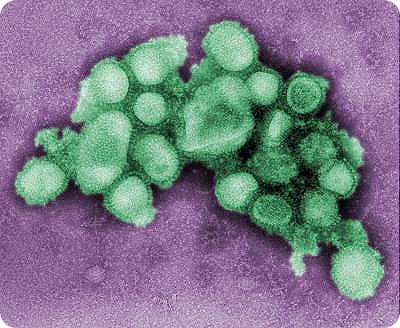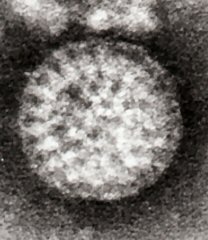We have come to the end of our blog. We hope that you have learnt much about what viruses are and how they reproduce. Thank you for viewing our blog.
Wednesday, 3 February 2010
Reverse Transcribing Viruses
Both types, DNA and RNA variants, involve the use of enzymes to integrate the viral genome into that of the host cell. In other words, these viruses are more or less of the latent type, where they will stay in you year upon year without causing any harm, then exploding out resulting in death.
One of the most important virus in this classification is the Hepatitis B virus, which is a DNA reverse transcribing virus. Transmission of the virus occurs via direct inoculation into blood, either by contaminated needles, blood transfusion or unprotected sex. It can also pass from the mother to unborn foetus via the placenta.
Hepatitis B virus infects the hepatocytes, or liver cells, causing inflammation, jaundice and even death. Latency in the cells can lead to liver cancer.
Liver cancer is one of the worse kinds of cancers to get, because the cancer itself is not very responsive to chemotherapy meaning that it is very hard to treat.
Tuesday, 2 February 2010
- Sense Single Stranded RNA Virus
Pandemic H1N1/09 Virus
The cause of the recent H1N1 pandemic is this virus. It is a random assortment of 5 different types of influenza viruses, one of which was a human influenza virus. Thus, this allowed the virus to spread amongst humans.
The virus itself is enveloped and enters the host cell via membrane fusion. Once within, positive hydrogen ions within the cytoplasm are channeled into the viral capsid where the pH change degrades the capsid protein, freeing the 8-segment negative sense RNA into the cytoplasm. There, RNA polymerases that were also released from the degradation of the capsid convert the negative sense into positive sense. After which, the RNA is transported via transporter protein to nearby ribosomes to be translated into proteins. After maturation, the new virions bud off the surface of the host cell, collecting their surface proteins and envelope at the same time.
The virulence of this virus is mild and its fatality rate is very low. All in all, not a very dangerous virus.
However, bearing in mind the use of RNA polymerase to convert the RNA leaves the genome highly susceptible to mutation, which is why scientists are monitoring the spread of the virus globally incase there is a mutation that causes the virus to become more virulent or more fatal.
Image of Pandemic H1N1/09

+ Sense Single Stranded RNA
Poliovirus
It is just as the name suggests, Poliovirus causes Polio. Polio is a highly virulent disease that leads to the damage or destruction of motor neurons. With their damage or destruction, paralysis will set in. In certain cases, the paralysis of certain skeletal muscles result in bone deformities that can lead to disability.
Poliovirus is a very simple virus, made up of only its capsid and RNA genome. Once it infects (Via fecal oral route) its victim however, the virus grows in the digestive tract and has a chance of entering the blood stream which can lead it to the brain or spinal cord, where it can spread to nerve cells.
In the body, the virus binds to special receptors on the target cells. This binding allows the virus to enter the host cell, where it uncoats and has its RNA immediately get translated by the host ribosomes. No conversion is needed due to the similarities between positive sense single stranded RNA and single stranded mRNA.
Due to the lack of cure for Polio, research began for a vaccine and and effort by the World Health Organisation (WHO) was started in 1988 to eradicate Polio. By 2006, Polio is only restricted to 4 countries, Nigeria, India, Pakistan and Afghanistan.
Image of Poliovirus
Double Stranded RNA Viruses
Rotavirus
This here, is not a very common virus. It is one of the causes of acute gastroenteritis, which is an inflammation of the stomach and/or small intestine. Gastroenteritis is usually not fatal, however in young children, the symptoms like diarrhea can be very severe.
This virus is transmitter via the fecal oral route and is not airborne. Therefore as long as the food you eat is clean and you are clean, you should not get infected by this virus.
Image of Rotavirus

Single Stranded DNA Viruses
Adeno-associated Virus
In this part of the blog, we will talk about the Adeno-associated Virus (AAV). This virus has its genome stored in single stranded DNA.
Now this virus is really small! Much smaller than your average virus. But what makes them really special is their inability to cause diseases upon infection!
Scientists have seen this potential and have exploited it to perform gene therapy. In these therapies, AAV are used as vectors to transport genes. However, the size of the gene is is limited by the relatively short length of the AAV genome. This means the large genes cannot be transported.
This virus infects a large variety of cells and have differing replication cycles depending on the type of cell.
Image of AAV

Double Stranded DNA Viruses
Varicella Zoster Virus
What we will be talking about in this post is the Varicella Zoster Virus (VZV), classified under herpesviridae meaning it is a type of herpes virus. It spreads via the air and close contact. This virus causes chicken pox in us and is usually a one time affair.
Why?
This is because the VZV is a DNA virus that transcribes its genome, from DNA to mRNA in the host cell nucleus. The presence of host cell DNA polymerase ensures that no mistakes will be made during transcription. This severely lowers the mutability of the virus meaning that once the body develops immunity against it (First chicken pox infection), new infection will not occur due to the ability of the immune system to recognise it easily and destroy it.
However, there is something else that is very important. During the first infection, when you are very sick, the symptoms are due to the lytic cycle of the VZV. At the same time however, certain cells are "reserved". In these cells, the VZV ONLY goes through the lysogenic cycle in them. These cells are the nerve cells.
Therefore after the initial infection you will never get chicken pox again however IF the virus resting within your nerve cells get activated, you will experience excruciating pain all over the body because nerve cells are spread all over.
Image of VZV

Monday, 1 February 2010
The Different Viruses!
Now that you know about how viruses reproduce, we will start talking about real viruses, how they infect and cause diseases in humans.

We will begin from group 1 all the way up to 7. With one type of virus for each.
Saturday, 30 January 2010
Virus Replication Cycle
As mentioned earlier, most viruses used the lytic cycle of replication that results in the eventual death of the host cell. Now, the lytic cycle of replication will be explained in detail.
The following steps are involved in the replication cycle:
1. Attachment
For virus to infect cells, they first have to attach to them. This is done via binding of viral surface proteins to molecules/receptors on the cell membrane or wall of the host cells. This is more or less general for all viruses that go through this cycle. The one thing here that sets ALL viruses apart is the specificity of the surface protein-receptor binding. Viruses have evolved in a way that their surface proteins are only able to bind to receptors on cells that they are able to replicate in.
For example, varicella zoster virus (Chicken Pox), DO NOT infect red blood cells due to the inability of their surface protein to bind to the surface receptors of the red blood cells. This evolution is due to the requirement of the varicella zoster virus as a DNA virus for the host cell to have a nucleus.
2. Penetration
After attaching to the host cell, viruses have 4 ways to enter the cell.
The first is Receptor mediated endocytosis. This occurs for virus that have an envelope. When the surface proteins of the virus bind with the receptors on the cell surface, a signal is produced that causes the cell to engulf the whole virion (A single virus particle), allowing the virion to enter the cell.
The second is Membrane fusion. This also for virus that possess an envelope. In this case, due to the similarities in membrane and envelope composition, they are able to fuse and the virion minus the envelope is able to enter the cell.
The third is Clathrin endocytosis. This method is for naked viruses, or viruses without an envelope. The clathrin induces the formation of vesicles within the cytoplasm that connect with the cell membrane, transporting the virion into the cell.
The final and and also the most uncommon of the 4 is Genome injection. This, as the name suggests is the injection of one or more tubes through the cell membrane then secreting ONLY the viral genome and necessary enzymes through. The rest of the virion remains outside the cell.
3. Uncoating
Only those virus that enter by endocytosis or fusion go through this step. This step involves the activation of proteins and enzymes within the virion that cause its capsid (Shell) to degrade, exposing the genetic material of the virion to the cytoplasm. These genetic material could then be transported to the nucleus if required.
4. Expression
This stage is the conversion of genome (If needed) and then letting ribosomes read it. Depending on the type of virus, this the conversion of genome occurs in different places. DNA conversion occurs in the nucleus whereas RNA conversion occurs in the cytoplasm. Conversion of viral genome is needed because ribosomes were made to read single mRNA strands. Therefore out of the 7 types of viruses in baltimore's classification mentioned earlier, only one type does not require conversion. This is the single stranded positive sense RNA virus.
This type of virus do not require conversion because the positive sense RNA itself is similar to RNA meaning it is already readable by ribosomes. However for the other types of genome, they have to be converted by polymerases to positive sense single stranded RNA before ribosomes can read them.
Now, this conversion is what leads to the high mutation rates of certain viruses. For DNA viruses, this is not really a problem, because during conversion in the nucleus, they are exposed to the host cell DNA polymerases which are able to correct mistakes in transcription. RNA viruses on the other hand, perform conversion in the cytoplasm with their own RNA polymerases. RNA polymerases lack the proof reading ability of DNA polymerases meaning that large changes to the genome could go undetected. This could lead to new protein formation that could in turn increase the virulence of that virus.
In this stage, the production of all viral proteins also begins.
5. Maturation
In this stage, the whole virions are assembled. For unenveloped viruses, they are ready to be released from the cell. For enveloped ones, they will obtain their final component in the next step.
6. Release
At this stage, there are two options. Lyse the cell, or bud off the cell.
Lysing the cell kills the cell instantly. This is performed by unenveloped viruses. After they are fully assembled, they gather in the cell until the cell is either full or exhausted of nutrients before bursting out and infecting surrounding cells.
Budding off the cell does not kill the cell instantly but weakens it till a point of eventual death. This is for enveloped viruses that once fully completed, bud of the cell taking a part of the cell membrane with it to form the envelope. As the continuous taking of membrane continues, the cell soon looses its ability to repair the membrane and dies.
The infection of the cell leading up to its death can be observed via certain symptoms, termed as cytopathic effects. These include multiple nuclei in the cell, empty cells, etc. They can be observed under a microscope with sufficient magnification power depending on the size of the host cells being viewed.
Viral Replication Cycle

Virus Reproduction
The reproduction of viruses involve two phases, the lysogenic cycle and the lytic cycle. Viruses usually skip the lysogenic cycle and go straight to the lytic cycle thus causing disease shortly after infection. Some viruses however go through the lysogenic cycle first, remaining dormant in the host until a certain trigger is supplied which causes the virus to go into the lytic cycle.

The first phase of virus reproduction is the lysogenic cycle. Though often skipped by many types of viruses, this phase is often involved in the replication of quite a few deadly viruses like HIV.
In this cycle, the whole or part of the viral genome is incorporated into the host cell genome. At each subsequent division, the viral-original genetic material is replicated. This allows the virus to infect more and more cells just by the normal mechanism of cell division.
The advantages of this phase is that by entering the host cell and fusing with the host DNA, the host cell functions as well as before the infection, meaning that the viral genome is propagated with each division for the whole length of the cell's lifespan.
Another advantage (Only for hosts with immune systems of some kind) is that by incorporation in the host cell DNA, the only way to remove the virus part of it is to kill the cell. Not only that, since the cells are functioning normally, there is virtually no way to differentiate the infected cells from the normal cells. This means that the virus can remain in the body for a very long time until the correct trigger is supplied.
The next phase of viral reproduction the lytic cycle. The lytic cycle is typically considered the main method of viral replication, since it results in the destruction of the infected cell.
Viruses of the lytic cycle are called virulent viruses. The lytic cycle is a six-stage cycle, called the virus replication cycle. In the first stage, called "penetration", the virus injects its own nucleic acids into a host cell. Then the viral acid form a circle in the center of the cell. Different viruses have different ways to trick the host cell ribosomes to read them instead of the host cell genome. at the end of the cycle, the number of viruses inside becomes too much for the cell to hold, the membrane splits and the viruses are free to infect other cells.
Here is a video to illustrate both phases.
Tuesday, 26 January 2010
Viral Infection and Central Dogma
One of the most important steps for viruses to infect us is through replicating million copies of themselves,using our cell's mechanisms.In short,they actually interrupted the theory used by many multi-cell organisms known as the Central Dogma.
The Central Dogma refers to a series of processes to make proteins.Proteins are important for our daily biological processes that makes us survive.The two main processes are transcription and translation which converts DNA into RNA and formation of polypetides respectively.
Let's check out a video made by the Japanese researchers to explain the Central Dogma in a creative way.
However,the viruses that are classified under the Baltimore's classification differs from the Central Dogma. In reality,the viruses diverse in all shapes and sizes. This is also similar for their genome.
The Central Dogma refers to a series of processes to make proteins.Proteins are important for our daily biological processes that makes us survive.The two main processes are transcription and translation which converts DNA into RNA and formation of polypetides respectively.
Let's check out a video made by the Japanese researchers to explain the Central Dogma in a creative way.
However,the viruses that are classified under the Baltimore's classification differs from the Central Dogma. In reality,the viruses diverse in all shapes and sizes. This is also similar for their genome.
Wednesday, 20 January 2010
Baltimore's Classification
One of them was Nobel laureate in Physiology or Medicine, David Baltimore.

He founded the "Baltimore's Classification", which classifies viruses into different families based on their type of genome and method of replication.
There are 7 families in this system:
1 - Double stranded DNA viruses
2 - Single stranded DNA viruses
3 - Double stranded RNA viruses
4 - Positive sense single stranded RNA viruses
5 - Negative sense single stranded RNA viruses
6 - Single stranded reverse transcribing RNA viruses
7 - Double stranded reverse transcribing DNA viruses

This system of classification is widely used today.
Introduction to Viruses
The world of viruses is as diverse as it is large.
Ignored by humans since ancient time, viruses went on to cause many different types of diseases which were either diagnosed as (This was really looong ago!) being cursed or being possessed by a spirit.
Later, as science progressed, man discovered bacteria in 1676. "Cursed" or "Spiritual Possession" diseases were subsequently (and proudly might I add) blamed on these hot new microorganisms by prominent biologists.
It was only more than 200 years later, in 1884, that scientists finally accepted their misconception with the isolation of tobacco mosaic virus by French microbiologist Charles Chamberland.

With that vital discovery, scientists rapidly began to step into uncharted territory, fueling the growth of the science that is now known as virology.
Many major discoveries have been made since then, including developing the first virus images and discovering that viruses were almost entirely composed by protein.

Towards the end of the 20th century, armed with the knowledge of virus structure, scientists began analyzing all known viruses in a bid to classify them...
Subscribe to:
Posts (Atom)

